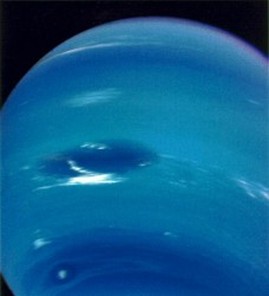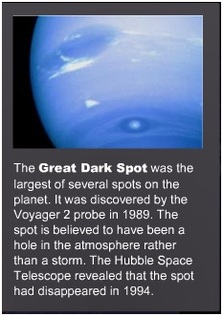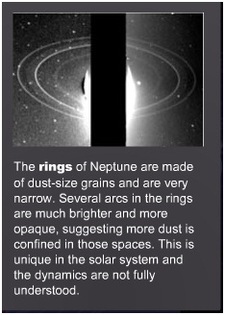Our Solar System
Neptune's Surface

Neptune is a gas giant planet, so it doesn’t have a solid surface. If you could dive down beneath the surface of Neptune, you would find an interior with increasing temperatures and pressures right down to the rocky core at the center.
The surface of Neptune isn’t solid. There’s no standing on Neptune. That said, the “surface of Neptune” that we see is one the most active and dynamic places in the Solar System. For some reason, that astronomers haven’t figured out, the interior of Neptune is unusually hot. Even though Neptune is much further from the Sun than Uranus and receives 40% less sunlight, its surface temperature is about the same. In fact, Neptune gives off 2.6 times more energy than it takes in from the Sun. Even without the Sun, Neptune glows.
This high amount of interior heat matched with the coldness of space creates a huge temperature difference. And this sets the winds blasting around Neptune. Maximum wind speeds on Jupiter can be more than 500 km/hour. That’s twice the speed of the strongest hurricanes on Earth. But that’s nothing compared to Neptune. Astronomers have calculated winds blasting across the surface of Neptune at 2,100 km/hour.
When NASA’s Voyager 2 spacecraft visited Neptune in 1989, it also discovered the planet’s Great Dark Spot, a huge storm like Jupiter’s Great Red Spot. But unlike Jupiter, the Dark Spot didn’t seem to be very stable, and had already disappeared by 1994 when the Hubble Space Telescope tried to locate it.
Deep down inside Neptune, the planet might have a solid surface. At the very core of Neptune is thought to be a region of rock with roughly the mass of the Earth. But temperatures at this region would be thousands of degrees; hot enough to melt rock. And the pressure from the weight of all the atmosphere would be crushing. There would be no way to walk around on the “surface of Neptune”.
The surface of Neptune isn’t solid. There’s no standing on Neptune. That said, the “surface of Neptune” that we see is one the most active and dynamic places in the Solar System. For some reason, that astronomers haven’t figured out, the interior of Neptune is unusually hot. Even though Neptune is much further from the Sun than Uranus and receives 40% less sunlight, its surface temperature is about the same. In fact, Neptune gives off 2.6 times more energy than it takes in from the Sun. Even without the Sun, Neptune glows.
This high amount of interior heat matched with the coldness of space creates a huge temperature difference. And this sets the winds blasting around Neptune. Maximum wind speeds on Jupiter can be more than 500 km/hour. That’s twice the speed of the strongest hurricanes on Earth. But that’s nothing compared to Neptune. Astronomers have calculated winds blasting across the surface of Neptune at 2,100 km/hour.
When NASA’s Voyager 2 spacecraft visited Neptune in 1989, it also discovered the planet’s Great Dark Spot, a huge storm like Jupiter’s Great Red Spot. But unlike Jupiter, the Dark Spot didn’t seem to be very stable, and had already disappeared by 1994 when the Hubble Space Telescope tried to locate it.
Deep down inside Neptune, the planet might have a solid surface. At the very core of Neptune is thought to be a region of rock with roughly the mass of the Earth. But temperatures at this region would be thousands of degrees; hot enough to melt rock. And the pressure from the weight of all the atmosphere would be crushing. There would be no way to walk around on the “surface of Neptune”.


